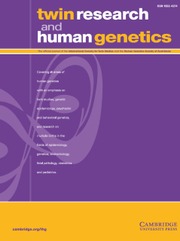In 2016 we (Stark & Otto, Reference Stark and Otto2016) published in this journal a brief account of the important role played by Edward Maxwell (‘Max’) Nicholls (1927–2011) in the development of the two-hit theory of cancer development, calling the attention to the in-depth analysis of scientific priority allocation by Kern (Reference Kern2002), who showed that his (Nicholls’s) ideas (N3, N4, N7) preceded those of Knudson (Reference Knudsen1971) by at least two years, despite the fact that only the latter was fully credited with the two-hit ideas. In order to keep the focus on the two-hit model of tumor formation, we left out his papers published after 1974, just commenting that Max’s interests had shifted to other subjects, mainly to immunology issues.
The present note, a complement to our 2016 paper, aims to present a complete list of Nicholls’ published papers, briefly commenting on his activities and importance on the subjects he dealt with after the two-hit hypothesis papers. All his publications took place when he was working at the Faculty of Medicine of the University of New South Wales (UNSW) in Sydney from 1964 to 1986 and at the Biomedical Engineering and Safety Science Departments of the Faculty of Engineering of UNSW from 1986 onwards. An interesting, candid, personal account of his experiences with genetics at UNSW was published by Stark (Reference Stark2020), who also pointed out that Dr Nicholls was a prominent figure in the formation of the Human Genetics Society of Australasia.
Although he concentrated his efforts on the area of immunology, a browsing of his list of publications makes absolutely clear that Nicholls never abandoned his attraction and interest for the study of the biology of tumor development.
For example, he was instrumental in the study of the buffy coat leuko-agglutination (BCLA) test, a sensitive assay for cell-mediated immunity he introduced to detect conditions (including cancer) in preclinical stages (N15, N23, N24, N25, N29, N31). No due credit was given him relative to this accomplishment, despite the fact that (1) he published his results and ideas in well-credited scientific periodicals; and that (2) direct descendants of the test are still essential and important tools in immunology and cancer research: for instance, it has been suggested recently that the analysis of molecular markers from circulating immune cells present in the buffy coat can be used to help the early diagnosis and treatment of different types of malignancies (Donzelli et al., Reference Donzelli, Blandino and Muti2016; Velez et al., Reference Velez, Pass, Carbone, Yang and Goparaju2021).
He also published short articles and reviews on nephroblastoma, the most common kidney malignant tumor affecting children (N11, N12, N13), histocompatibility testing (N16), pigmentation genetics (N17), and human gene mapping (N18), and authored or coauthored papers on several important subjects of practical and applied medicine (N22, N33, N34, N35, N36).
All other published papers deal with hypotheses on tumor immunity, autoimmune diseases and the evolution of the immune system (N19, N20, N21, N30) or with the immunology of pregnancy and embryonic development (N26, N27, N28, N32).
Most of Nicholls’ ideas, discoveries and hypotheses were important at least at the time of their publication. While his seminal contributions on the theme of the two-hit cancer hypothesis might be already tacitly accepted (Kern, Reference Kern2002; Stark & Otto, Reference Stark and Otto2016), the ones developed after the two-hit hypothesis (despite revealing the author’s pristine and immaculate qualities as an excellent and earnest scientist), submerged amid the incredibly vast plethora of exceptionally good papers dealing with practical and theoretical applications of immunology and cancer research. Unfortunately, scientific papers have on average a very short half-life, irrespective of their scientific value, because science works exactly like everything else in this physical world, that is, on a trial and error basis, with a never-ending adjustment and/or accommodation motion, what straightforwardly justifies the phrase ‘Today’s science is tomorrow’s error’, a plain translation from ‘Die Wissenschaft von heute ist der Irrtum von morgen’, as stated by the famous German biologist Jakob von Uexküll in 1900 (Aschill, Reference Aschill2017).
We think that this note might be justified by pointing out how the scientific milieu in general and universities in particular fail at times to adequately recognize the exceptional talents of their more-than-prepared minds.


